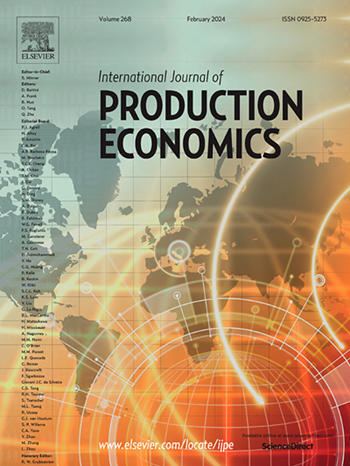To Cooperate or Not: Evaluating process innovation strategies in battery recycling and product innovation
IF 9.8
1区 工程技术
Q1 ENGINEERING, INDUSTRIAL
引用次数: 0
Abstract
Emerging technology products like retired electric vehicle (EV) batteries encounter technical challenges during the collecting and remanufacturing phase. Process innovation for recycling (PIR) presents an opportunity to improve the efficiency of these product recycling processes. To investigate how upstream and downstream firms formulate optimal PIR strategies under the interaction of product innovation and PIR, and to analyze the impact of this interaction on operational decisions, we construct Stackelberg game models comprising a battery supplier and an EV manufacturer, both of which have the potential to assume leadership roles. The supplier engages in recycling and makes PIR investment decisions: invest independently, outsource it to the manufacturer, or cooperate with the manufacturer. The manufacturer performs product innovation and decides whether to participate in PIR. Our results indicate that cooperation is not always the preferred strategy for both firms and tends to be favored only when PIR investment efficiency is relatively low. Although the supplier engages in remanufacturing, the manufacturer may exert higher PIR efforts. When product innovation and PIR are carried out separately by upstream and downstream firms, the two innovations maintain a complementary relationship, which provides the possibility for manufacturers to offer higher-quality products at lower prices. Furthermore, firms are more inclined to invest in PIR when acting as the supply chain leader. However, the first-mover advantage may turn into a disadvantage under collaboration model, which provides insights for firms not to blindly pursue the leader. The sequential innovation decisions and two-period model settings are further explored as model extensions.
合作还是不合作:评价电池回收和产品创新的工艺创新策略
退役电动汽车电池等新兴技术产品在回收和再制造阶段遇到了技术挑战。工艺创新的回收(PIR)提出了一个机会,以提高这些产品回收过程的效率。为了研究上下游企业在产品创新和PIR相互作用下如何制定最优PIR策略,并分析这种相互作用对运营决策的影响,我们构建了由电池供应商和电动汽车制造商组成的Stackelberg博弈模型,这两家公司都有可能担任领导角色。供应商从事回收,并做出PIR投资决策:独立投资,外包给制造商,或与制造商合作。制造商进行产品创新并决定是否参与PIR。我们的研究结果表明,合作并不总是双方企业的首选策略,只有在PIR投资效率相对较低时才倾向于合作。虽然供应商参与再制造,但制造商可能会付出更高的PIR努力。当上下游企业分别进行产品创新和PIR时,两种创新保持互补关系,这为制造商以更低的价格提供更高质量的产品提供了可能。此外,作为供应链领导者的企业更倾向于投资于PIR。然而,在合作模式下,先发优势可能会变成劣势,这为企业不盲目追求领导者提供了启示。作为模型的扩展,进一步探讨了顺序创新决策和两期模型设置。
本文章由计算机程序翻译,如有差异,请以英文原文为准。
求助全文
约1分钟内获得全文
求助全文
来源期刊
CiteScore
21.40
自引率
7.50%
发文量
266
审稿时长
52 days
期刊介绍:
The International Journal of Production Economics focuses on the interface between engineering and management. It covers all aspects of manufacturing and process industries, as well as production in general. The journal is interdisciplinary, considering activities throughout the product life cycle and material flow cycle. It aims to disseminate knowledge for improving industrial practice and strengthening the theoretical base for decision making. The journal serves as a forum for exchanging ideas and presenting new developments in theory and application, combining academic standards with practical value for industrial applications.

 求助内容:
求助内容: 应助结果提醒方式:
应助结果提醒方式:


